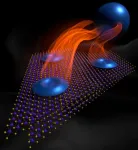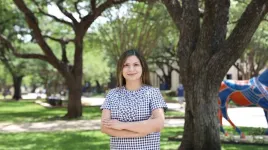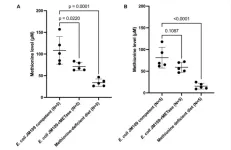University of Washington
206-543-2580
jurton@uw.edu
(Note: researcher contact information at the end)
For immediate release
June 27, 2023
Researchers make a quantum computing leap with a magnetic twist
Quantum computing could revolutionize our world. For specific and crucial tasks, it promises to be exponentially faster than the zero-or-one binary technology that underlies today’s machines, from supercomputers in laboratories to smartphones in our pockets. But developing quantum computers hinges on building a stable network of qubits — or quantum bits — to store information, access it and perform computations.
Yet the qubit platforms unveiled to date have a common problem: They tend to be delicate and vulnerable to outside disturbances. Even a stray photon can cause trouble. Developing fault-tolerant qubits — which would be immune to external perturbations — could be the ultimate solution to this challenge.
A team led by scientists and engineers at the University of Washington has announced a significant advancement in this quest. In a pair of papers published June 14 in Nature and June 22 in Science, they report that, in experiments with flakes of semiconductor materials — each only a single layer of atoms thick — they detected signatures of “fractional quantum anomalous Hall” (FQAH) states. The team’s discoveries mark a first and promising step in constructing a type of fault-tolerant qubit because FQAH states can host anyons — strange “quasiparticles” that have only a fraction of an electron’s charge. Some types of anyons can be used to make what are called “topologically protected” qubits, which are stable against any small, local disturbances.
“This really establishes a new paradigm for studying quantum physics with fractional excitations in the future,” said Xiaodong Xu, the lead researcher behind these discoveries, who is also the Boeing Distinguished Professor of Physics and a professor of materials science and engineering at the UW.
FQAH states are related to the fractional quantum Hall state, an exotic phase of matter that exists in two-dimensional systems. In these states, electrical conductivity is constrained to precise fractions of a constant known as the conductance quantum. But fractional quantum Hall systems typically require massive magnetic fields to keep them stable, making them impractical for applications in quantum computing. The FQAH state has no such requirement — it is stable even “at zero magnetic field,” according to the team.
Hosting such an exotic phase of matter required the researchers to build an artificial lattice with exotic properties. They stacked two atomically thin flakes of the semiconductor material molybdenum ditelluride (MoTe2) at small, mutual “twist” angles relative to one another. This configuration formed a synthetic “honeycomb lattice” for electrons. When researchers cooled the stacked slices to a few degrees above absolute zero, an intrinsic magnetism arose in the system. The intrinsic magnetism takes the place of the strong magnetic field typically required for the fractional quantum Hall state. Using lasers as probes, the researchers detected signatures of the FQAH effect, a major step forward in unlocking the power of anyons for quantum computing.
The team — which also includes scientists at the University of Hong Kong, the National Institute for Materials Science in Japan, Boston College and the Massachusetts Institute of Technology — envisions their system as a powerful platform to develop a deeper understanding of anyons, which have very different properties from everyday particles like electrons. Anyons are quasiparticles — or particle-like “excitations” — that can act as fractions of an electron. In future work with their experimental system, the researchers hope to discover an even more exotic version of this type of quasiparticle: “non-Abelian” anyons, which could be used as topological qubits. Wrapping — or “braiding” — the non-Abelian anyons around each other can generate an entangled quantum state. In this quantum state, information is essentially “spread out” over the entire system and resistant to local disturbances — forming the basis of topological qubits and a major advancement over the capabilities of current quantum computers.
“This type of topological qubit would be fundamentally different from those that can be created now,” said UW physics doctoral student Eric Anderson, who is lead author of the Science paper and co-lead author of the Nature paper. “The strange behavior of non-Abelian anyons would make them much more robust as a quantum computing platform.”
Three key properties, all of which existed simultaneously in the researchers’ experimental setup, allowed FQAH states to emerge:
Magnetism: Though MoTe2 is not a magnetic material, when they loaded the system with positive charges, a “spontaneous spin order” — a form of magnetism called ferromagnetism — emerged. Topology: Electrical charges within their system have “twisted bands,” similar to a Möbius strip, which helps make the system topological. Interactions: The charges within their experimental system interact strongly enough to stabilize the FQAH state. The team hopes that, using their approach, non-Abelian anyons await for discovery.
“The observed signatures of the fractional quantum anomalous Hall effect are inspiring,” said UW physics doctoral student Jiaqi Cai, co-lead author on the Nature paper and co-author of the Science paper. “The fruitful quantum states in the system can be a laboratory-on-a-chip for discovering new physics in two dimensions, and also new devices for quantum applications.”
“Our work provides clear evidence of the long-sought FQAH states,” said Xu, who is also a member of the Molecular Engineering and Sciences Institute, the Institute for Nano-Engineered Systems and the Clean Energy Institute, all at UW. “We are currently working on electrical transport measurements, which could provide direct and unambiguous evidence of fractional excitations at zero magnetic field.”
The team believes that, with their approach, investigating and manipulating these unusual FQAH states can become commonplace — accelerating the quantum computing journey.
Additional co-authors on the papers are William Holtzmann and Yinong Zhang in the UW Department of Physics; Di Xiao, Chong Wang, Xiaowei Zhang, Xiaoyu Liu and Ting Cao in the UW Department of Materials Science & Engineering; Feng-Ren Fan and Wang Yao at the University of Hong Kong and the Joint Institute of Theoretical and Computational Physics at Hong Kong; Takashi Taniguchi and Kenji Watanabe from the National Institute of Materials Science in Japan; Ying Ran of Boston College; and Liang Fu at MIT. The research was funded by the U.S. Department of Energy, the Air Force Office of Scientific Research, the National Science Foundation, the Research Grants Council of Hong Kong, the Croucher Foundation, the Tencent Foundation, the Japan Society for the Promotion of Science and the University of Washington.
###
For more information, contact Xu at xuxd@uw.edu, Anderson at eca55@uw.edu and Cai at caidish@uw.edu.
Grant numbers:
U.S. Department of Energy: DE-SC0018171, DE-SC0019443, DE-SC0012509
Air Force Office of Scientific Research: FA9550-19-1-0390, FA9550-21-1-0177
National Science Foundation: DMR-1719797, DGE-2140004
Research Grants Council of Hong Kong: AoE/P-701/20, HKU SRFS2122-7S05
Japan Society for the Promotion of Science: 19H05790, 20H00354, 21H05233 END






